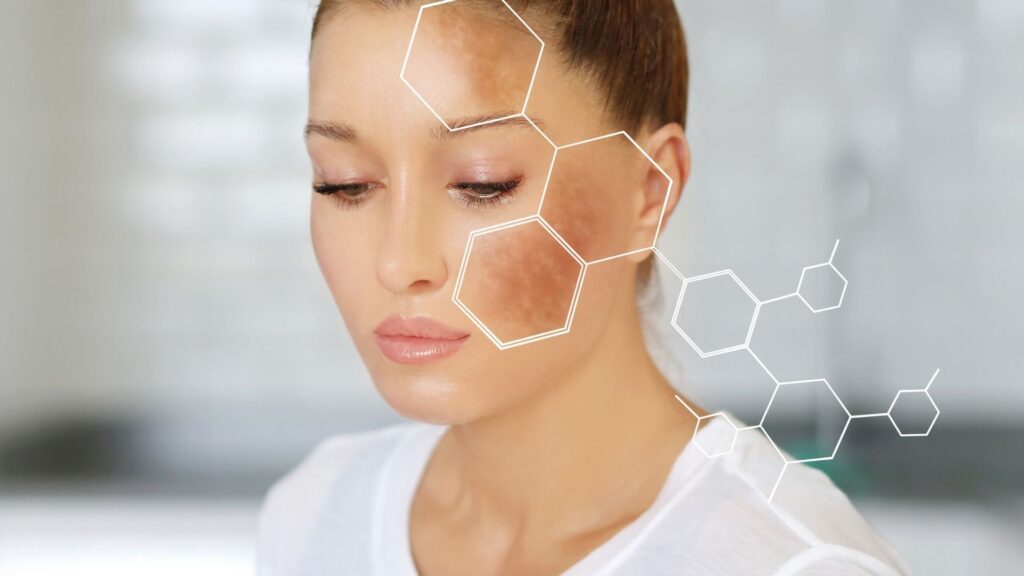Melasma is a frustrating skin condition that shows up as dark, blotchy patches of pigmentation, most commonly on the face. It can affect anyone, though it’s more common in women and people with medium to darker skin tones. Because the condition is notoriously difficult to treat, many people look for alternative therapies.
One treatment that’s been getting a lot of buzz in skincare and dermatology circles is red light therapy (RLT). This article explains whether RLT actually works for melasma.

What Exactly Is Melasma and Why Does It Happen?
Melasma is a form of hyperpigmentation that appears as brown, gray, or sometimes blue-gray patches on areas of the face that get the most sun, such as the cheeks, forehead, upper lip, nose, and chin. These patches form when melanocytes, the cells responsible for producing melanin, the pigment that gives skin, hair, and eyes their color, become overactive and release too much pigment.
Several factors can trigger this process. Hormonal changes are one of the biggest reasons this condition develops, which is why it’s often linked to pregnancy, birth control pills, or hormone therapy. Sun exposure also plays a major role, as ultraviolet (UV) rays directly stimulate melanocytes and worsen pigmentation. For some people, genetics makes them more likely to develop this condition if it runs in their family. In addition, certain medications and even chronic skin irritation can push melanocytes into overdrive and contribute to the appearance of dark patches.
Although this skin issue doesn’t cause any physical harm, it is a stubborn condition that often resists traditional treatments. Even when the discoloration fades, it has a tendency to return, making it a long-term skin concern that can be frustrating.
What Is Red Light Therapy and How Does It Work on the Skin?
Red light therapy, also known as low-level light therapy (LLLT) or photobiomodulation, is a non-invasive treatment where skin is exposed to low-energy red and near-infrared wavelengths, typically 600–850 nanometers. Unlike UV rays, which damage the skin, red light is safe and penetrates deeply into the skin’s layers.
The magic happens when this type of light stimulates the mitochondria, the cell’s powerhouses, to produce more adenosine triphosphate (ATP), which is the energy currency of cells. With more ATP, cells function better, repair themselves faster, and regulate processes more efficiently.
While RLT is originally used for wound healing and tissue regeneration, it is now widely studied for its effectiveness in reducing inflammation, boosting collagen, and evening out skin tone, all of which play a role in treating melasma.
With its growing popularity, many people are exploring options for red light therapy in FL as a way to improve skin health through a safe and non-invasive approach.
Benefits of Red Light Therapy for Melasma
RLT addresses this skin problem at the cellular and biochemical level in several ways:
- Regulating melanocytes: RLT reduces excessive melanin production without damaging the surrounding skin by calming overactive melanocytes.
- Boosting collagen production: Red light stimulates collagen production, specifically fibroblasts, which build collagen and elastin. This strengthens skin structure, smooths texture, and helps balance pigmentation.
- Reducing inflammation: Inflammation worsens melasma by making melanocytes more reactive. RLT’s anti-inflammatory effects calm the skin, helping prevent flare-ups.
- Improving circulation and healing: Better blood flow delivers oxygen and nutrients, speeding up the repair and renewal of skin cells, which helps fade uneven patches.

Best Red Light Wavelengths to Reduce Melasma
Not all light wavelengths penetrate the skin the same way, and the 600–850 nanometer range is the sweet spot for skin therapies. Wavelengths between 630 and 660 nanometers, which fall within the visible red light spectrum, penetrate the dermis, stimulate collagen production, regulate melanocytes, and help improve overall skin tone.
Near-infrared wavelengths between 810 and 850 nanometers go deeper into the tissue, where they work to reduce inflammation and promote circulation, both of which indirectly support pigment regulation.
Wavelengths around 940 nanometers may influence genes related to melanin production, offering another pathway to manage pigmentation. Because each range provides unique benefits, using a device that combines both red and near-infrared light is often considered the most effective approach for treating this skin blemish.
Tailoring Red Light Therapy: Fair Skin vs. Darker Skin Tones
Skin tone can influence how well RLT works and how it should be applied. For individuals with fair skin who are more sensitive to light, lower-intensity therapy sessions or shorter durations may be ideal to avoid redness or temporary irritation.
People with darker skin types have melanocytes that are naturally more active, which can make melasma harder to treat. Near-infrared wavelengths (800–850 nm) are often recommended since they penetrate deeply and reduce inflammation without overstimulating pigment.
No matter the skin type, treatment should be gradual and consistent, typically a few sessions per week for several weeks or months. Dermatologist guidance ensures the best results and avoids paradoxical darkening.
Final Thoughts from Quantum Wellness Center
Melasma is a complex condition influenced by hormones, sun exposure, genetics, and other triggers, which makes it challenging to manage. However, RLT may offer meaningful benefits by calming overactive melanocytes, reducing inflammation, supporting collagen production, and improving overall skin tone. While it is not a quick cure, consistent and properly guided treatments can help many individuals see gradual improvement in their skin.
At Quantum Wellness Center, we provide infrared bed therapy in Sarasota, FL, using wavelengths shown to support skin health and cellular repair. Our approach is designed to complement individual treatment plans and offer a non-invasive option for those exploring ways to manage melasma.



